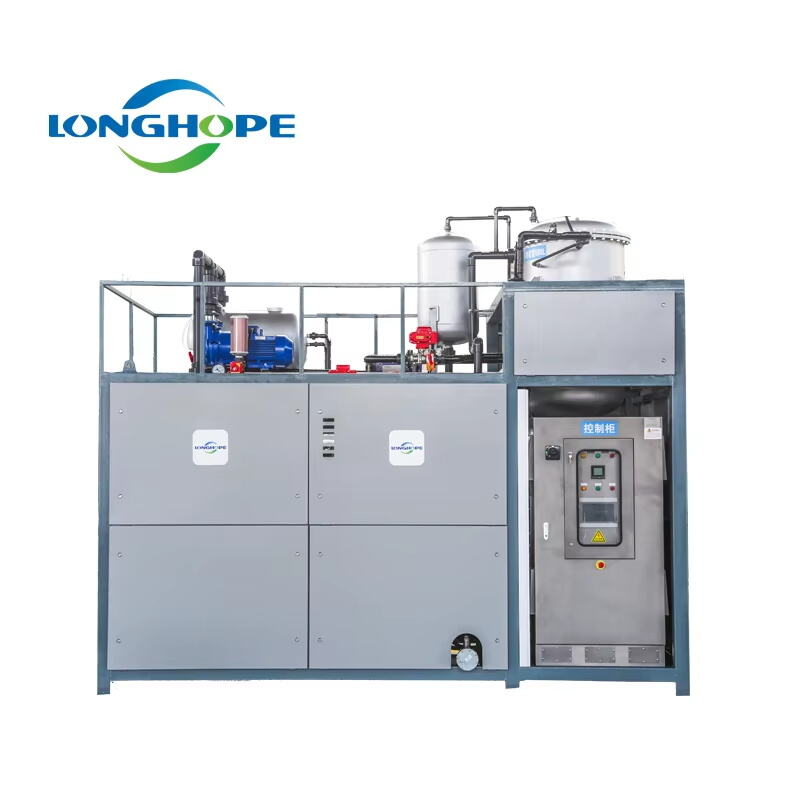Introduction to Low Temperature Crystallization Machines
Importance in Industrial and Laboratory Settings
Low temp crystallization equipment plays a really important part in factories and labs because it gives researchers exact control during crystal formation. Getting this control right matters a lot when making good quality crystals that matter across different fields like medicine, food manufacturing, and chemicals. Take the drug sector for example the way crystals form affects how well medications work and whether they're safe to take. These machines also help manage heat better throughout the process, which means more product comes out each time and experiments don't vary so much from run to run. Reliable outcomes are what everyone wants, especially in places where things need to be consistent batch after batch and where top notch quality just isn't optional.
Role in Material Processing and Quality Control
When working with materials, low temperature crystallization equipment plays a major role in determining results because it affects things like how big and shaped the crystals become, factors that directly influence what the finished product will be like. Getting this right matters a lot for stuff like electronic components and high tech materials, since even small changes in crystal characteristics can make a big difference in how well they work. These machines also help keep quality consistent across batches, making sure everything fits within tight manufacturing specs and meets required industry benchmarks. Companies that implement them properly often see better efficiencies and purer end products too something that really cuts down on waste and saves money in the long run. So while they definitely improve product quality, there's also solid financial benefits from using these systems in modern manufacturing setups.
Key Factors for Choosing a Low Temperature Crystallization Machine
Capacity: Matching Machine Size to Production Demands
Picking out a low temperature crystallization machine starts with getting clear on what the production line actually needs. A machine sized correctly for those needs will keep things running smoothly without creating delays or burning through cash unnecessarily. Overbuying equipment means spending money on something bigger than needed, which just sits there collecting dust. On the flip side, going too small creates all sorts of headaches down the road when demand spikes and the system can't keep up. The sweet spot comes from looking at historical production numbers and seeing where the peaks happen. Most manufacturers find they need to account for seasonal fluctuations or unexpected orders that come in last minute. Looking at this data gives a better picture of what kind of capacity makes sense rather than guessing based on gut feelings alone.
Temperature Range: Ensuring Compatibility with Material Requirements
When picking out a crystallization machine, temperature range matters a lot because various materials need different temps to work right. A good match between what the machine can do and what the material requires makes all the difference in getting decent results without messing up the material itself. For stuff that's extra sensitive like certain polymers or pharmaceutical compounds, even small temp variations can wreck their whole structure during processing. Don't forget about outside temps either since these affect how well machines run and ultimately impact product quality. Getting this stuff straight about materials plus knowing how surroundings play into it just makes sense for anyone serious about producing quality products consistently.
Automation Level: Manual vs. Semi-Automatic vs. Fully Automatic
How automated a crystallization machine is makes a big difference in how smoothly things run day to day and what kind of resources are needed. With manual machines, operators have complete control at their fingertips, which means they can tweak settings on the fly when something isn't quite right. But this comes at a cost since these machines demand constant attention and technical know-how from staff members. Semi automatic models take a middle road approach, handling basic tasks automatically while still leaving room for human input where necessary. The fully automatic systems deliver maximum output rates and consistent results across batches, cutting down on the need for someone to constantly watch over them. However, even with all that automation, facilities still need experienced personnel who understand how to monitor performance metrics and step in when problems arise. Looking at what skills current employees actually possess versus what different levels of automation require should guide any decision about upgrading equipment in production areas.
Applications and Material Compatibility
Chemical Industry: Handling Sensitive Compounds
Cold crystallization plays a really important role in chemical manufacturing, particularly for those tricky substances that break down easily. Many sensitive materials need just the right temperature settings during processing so they don't lose their effectiveness or get ruined altogether. That's where low temperature crystallization equipment comes in handy. These systems actually create the fine balance necessary to keep things from breaking down too much while still keeping all the good qualities intact. Plus, companies find that investing in such machinery pays off because it boosts production yields significantly. The controlled environment means less material gets wasted, and products tend to meet quality specs time after time without fail.
Pharmaceuticals: Meeting Sterilization and Purity Standards
Pharma companies depend a lot on cold crystallization processes because they need their products to hit those tough purity and safety requirements. Getting just the right crystal formation matters a ton for active pharmaceutical ingredients or APIs as they call them. Without proper crystallization, these compounds might lose their potency or become unstable over time. Since medicines have to be so pure and follow all sorts of regulations, most manufacturers end up spending big bucks on fancy crystallization equipment. These machines help keep everything within legal limits while making sure batches come out consistent from one run to the next. And let's face it, inconsistent drug quality can lead to recalls or worse, patient harm.
Food Processing: Ensuring Safety and Compliance
Low temperature crystallization matters a lot in food processing because it helps keep products safe and meets those pesky health regulations we all have to follow. When picking machinery for this process, manufacturers need to check if the equipment actually uses food grade materials and sticks to proper safety protocols during operation. Good quality machines help produce consistent results, making sure what ends up on store shelves is both safe to eat and maintains its quality. They also cut down on bacteria risks which nobody wants when talking about food safety. Beyond just following rules, these machines let companies show they care about consumer health while still delivering tasty, trustworthy food products to market.
Budget Considerations and Maintenance Requirements
Balancing Initial Cost with Long-Term Efficiency
Buying low temperature crystallization machines requires looking at both what they cost up front and how well they perform over time. Sure, these machines come with a hefty price tag initially, but thinking about everything else involved matters just as much. A pricier model that runs efficiently might actually save money later on because it doesn't eat through electricity bills or need constant repairs. Smart buyers always get several quotes from different suppliers so they can really see what options are available. Taking all this information together helps companies pick equipment that fits within their financial plans while still getting good performance out of their investment.
Routine Maintenance and Service Accessibility
Regular maintenance matters a lot if we want our low temperature crystallization machines running smoothly for years. Setting up a consistent maintenance plan catches small problems early before they turn into big headaches down the road. It's also important to check where service providers and replacement parts can be found locally because nobody wants their operation grinding to a halt waiting for something to arrive from across town. When companies make sure these resources are within reach, production stops become rare events instead of regular occurrences, keeping things efficient and saving money in the long run without breaking the bank on unexpected repairs.
Evaluating Manufacturer Support and Warranty
When looking at crystallization equipment purchases, checking out what kind of support manufacturers offer along with their warranty terms really matters. Good manufacturer support makes all the difference when problems pop up, helping keep production lines running instead of grinding to a halt. Take time to read through those warranty documents thoroughly because they tell quite a story about what gets covered for repairs or upgrades down the road, which affects pocketbooks over time. Don't forget to check how reputable the company actually is too. A solid track record usually means better quality products and decent customer service, making the whole ownership journey much less stressful in practice than it sounds on paper.
Conclusion: Making an Informed Decision
Prioritizing Needs vs. Features
Picking out a low temp crystallization machine requires putting actual needs ahead of flashy features if we want it to work well for our operations. First step is figuring out what exactly matters most in production and making sure whatever machine we look at actually supports those basics. We tend to get tempted by all sorts of bells and whistles, but what really counts are the functions that actually improve how things run day to day. A good approach? Write down must-have specs according to what our facility actually needs. This simple list helps cut through marketing fluff when shopping around, keeping attention where it should be instead of chasing extras that don't matter much in practice.
Future-Proofing Your Investment
Smart investing means thinking ahead so businesses can grow alongside changing tech and market needs. When picking out new gear, it pays to think about what materials might come next year or how much more production capacity could be needed down the road. Machines that allow upgrades later on are worth considering because they help avoid getting stuck with outdated equipment when better options emerge. Looking at what's happening in technology isn't just good practice either. Companies that track industry developments tend to spot opportunities earlier than competitors who wait until problems arise. Investing wisely in adaptable systems now often makes all the difference between struggling through changes and smoothly adapting to them as time goes on.
FAQ
What are low temperature crystallization machines used for?
Low temperature crystallization machines are used for precise control over crystallization processes in various industries, such as pharmaceuticals, food processing, and chemical production.
Why is temperature range important when selecting these machines?
Temperature range is crucial because different materials require specific temperatures for optimal crystallization, ensuring the integrity and quality of the final product.
How does automation level affect machine operations?
The level of automation affects workflow efficiency; manual, semi-automatic, or fully automatic machines offer varying degrees of control and require different levels of human oversight.
Why is manufacturer support and warranty important?
Manufacturer support and warranty are important as they ensure quick issue resolution, minimizing production disruptions and affecting long-term costs.

